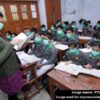Widespread Covid-19 vaccination before reopening schools not required: World Bank
Evidence suggests that young children are less likely to contract Covid-19 and given the “safe” school reopening experiences in various countries prior to vaccine development, education systems do not need to wait for widespread vaccination before returning to offline schooling, according to the World Bank.
The World Bank’s education team has noted that the experiences from countries around the world where schools have reopened suggest that with adequate mitigation strategies, schools pose low risks for disease transmission among students, staff, and communities.
The team has also noted that one year after the pandemic hit, we know much more about both the virus and the disease and how to mitigate transmission and health authorities like the WHO recommend school closures only as a “last resort”.
“Available evidence suggests that young children are less likely to contract Covid-19, less likely to become seriously ill or die and less likely to transmit the disease to others. Transmission within schools has been low, particularly for pre-primary and primary schools, and staff in schools are more likely to get the virus from other staff, not from students,” the World Bank said.
“Given the safe reopening experiences in countries prior to vaccine development, often in the midst of high community transmission, education systems do not need to wait for widespread vaccination of school staff or other adults in the community before reopening, although prioritizing school staff for vaccination may allay fears of returning to schools for in-person instruction,” it added.
The note said that keeping schools closed eliminates the risk of disease transmission at school, but it also imperils children’s learning, psychosocial health, and overall development.
“School reopening decisions should reflect evidence-based estimates of the risks associated with reopening schools and the risks associated with keeping schools closed.
Experiences from countries around the world where schools have reopened suggest that with adequate mitigation strategies, schools pose low risks for disease transmission among students, staff, and communities,” it said.
According to World Bank’s statistics, 80 percent of schools worldwide are in regular session. Out of those, 54 percent are back to in-person instruction, 34 percent are relying on mixed or hybrid instruction while 10 percent continue remote instruction and 2 percent offer no instruction at all.
“Schools have remained closed where governments, communities, teachers, or parents fear that reopening schools poses too great a risk for disease transmission. In each context, it is important to quantify the risks associated with reopening schools, as well as the risks of keeping schools closed, so that reopening decisions can be based on risk assessments informed by evidence.
Last year, the Covid-19 pandemic led to a global shut down of schools in more than 188 countries, leaving 1.6 billion children — 75 percent of enrolled students — out of school.
“As the COVID-19 pandemic spread within and across countries at the start of 2020, we knew very little about the virus: how it spread, who would be most affected, and how to treat it. To protect children and slow disease transmission, most governments reacted by closing schools. “One year later, we know much more about both the virus and the disease and how to mitigate transmission and health authorities like the WHO recommend school closures only as a last resort,” it said.
Citing evidence about low transmission of Covid-19 among children, the World Bank said data from population surveillance studies and contact tracing studies suggest that in comparison to adults and adolescents, young children, particularly those under the age of ten, are considerably less susceptible to contracting Covid-19 and much less likely to transmit the disease.
“Among children who do get Covid-19, severe illness and death are rare and most commonly occur among children with other underlying illnesses,” it said.
Also Read:
School closure may cost $400 bn to India: World Bank
















Add comment